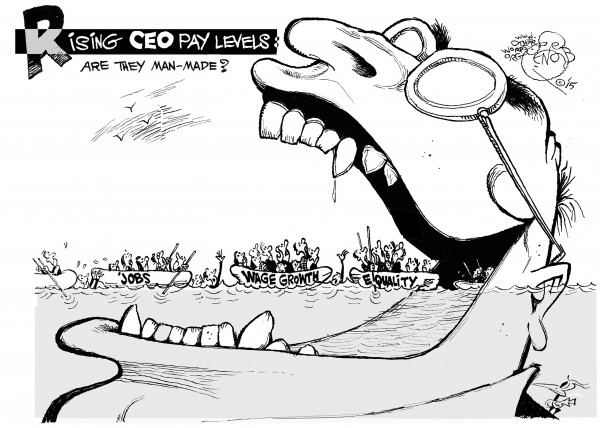
Oil permeates the whole economy. Even if you telework in a solar-powered home and tote your groceries home by bicycle, the price of petroleum affects what you spend on goods and services.
This impact, of course, is uneven. The collapse from $105 per barrel last summer to as little as $37.75 in late August in US oil prices brought relief to wallets across America – while kneecapping the industry’s profits and costing tens of thousands of workers their jobs.
But one tiny segment of the oil workforce isn’t hurting.
 Rising CEO Pay Levels, an OtherWords cartoon by Khalil Bendib.
Rising CEO Pay Levels, an OtherWords cartoon by Khalil Bendib.
The buck stopped elsewhere for ExxonMobil CEO Rex W. Tillerson, who pocketed $33.1 million in 2014. ConocoPhillips CEO Ryan M. Lance raked in $27.6 million, netting an 18 percent raise. And Chevron CEO John S. Watson, whose company recently cut 1,500 jobs, took home $26 million.
Tillerson, Lance, and Watson topped the list when a team of my Institute for Policy Studies colleagues catalogued what the nation’s 30 biggest publicly traded oil, gas, and coal companies paid their leading executives last year.
This new report, Money to Burn: How Our CEO Pay System is Accelerating Climate Change, shows that these Big Fossil giants handed their chief executive officers a total of $442.1 million as their profits stalled, fell, or – in the case of the Peabody Energy coal company – ran big losses.
My colleagues added up all the money the highest-paid officers of each company took home over the past five years. It amounted to nearly $6 billion.
What else could that $6 billion cover? One possibility: creating nearly 100,000 green-energy jobs for a year, the report’s authors estimate based on prior research.
Although the Obama administration’s early efforts to goose green employment faltered, renewable-energy jobs are booming now.
The number of Americans employed in the solar, wind, geothermal, biofuels, and small-scale hydropower industries soared to 724,000 last year, according to the International Renewable Energy Agency. That marks a 16 percent gain from 2013, boosted by a 43 percent surge in wind-power employment.
The solar industry is also fueling this growth. It’s gaining jobs 10 times faster than the overall economy, and there are now more than twice as many solar workers as coal miners. At this rate, renewable-energy workers will soon outnumber people toiling in fossil-fuel industries.
Employment in the “mining and quarrying sector,” a category that lumps oil, gas, and coal together, fell to 781,500 jobs in July from 848,000 a year earlier, the Bureau of Labor Statistics found.
With strategic support and public-private cooperation, thousands of unemployed oil workers and coal miners could potentially land wind and solar jobs.
Given their industries’ breakneck growth, green-energy employers can struggle to find new workers with the right skills. To bridge this gap, the government is ginning up green-job training.
One promising example is the Solar Ready Vets program. Since this pilot’s launch a year ago, 100 transitioning service members from Naval Station Norfolk in Virginia, Fort Carson in Colorado, and Camp Pendleton in California have gotten training. Every former soldier, marine, and sailor who completed these six-week courses landed at least one job offer in the solar industry, according to the Energy Department – which picked up the tab for the trainees’ tuition, materials, and exam fees.
A big draw for this growing industry is the competitive pay. Wages range between $20 and $60 an hour, according to the Solar Foundation.
That’s a mere sliver of the $14.7 million haul those 30 oil, gas, and coal CEOs averaged last year. But it’s a living wage in a business that’s curbing pollution and could help slow the pace of climate change.
We’re not backing down in the face of Trump’s threats.
As Donald Trump is inaugurated a second time, independent media organizations are faced with urgent mandates: Tell the truth more loudly than ever before. Do that work even as our standard modes of distribution (such as social media platforms) are being manipulated and curtailed by forces of fascist repression and ruthless capitalism. Do that work even as journalism and journalists face targeted attacks, including from the government itself. And do that work in community, never forgetting that we’re not shouting into a faceless void – we’re reaching out to real people amid a life-threatening political climate.
Our task is formidable, and it requires us to ground ourselves in our principles, remind ourselves of our utility, dig in and commit.
As a dizzying number of corporate news organizations – either through need or greed – rush to implement new ways to further monetize their content, and others acquiesce to Trump’s wishes, now is a time for movement media-makers to double down on community-first models.
At Truthout, we are reaffirming our commitments on this front: We won’t run ads or have a paywall because we believe that everyone should have access to information, and that access should exist without barriers and free of distractions from craven corporate interests. We recognize the implications for democracy when information-seekers click a link only to find the article trapped behind a paywall or buried on a page with dozens of invasive ads. The laws of capitalism dictate an unending increase in monetization, and much of the media simply follows those laws. Truthout and many of our peers are dedicating ourselves to following other paths – a commitment which feels vital in a moment when corporations are evermore overtly embedded in government.
Over 80 percent of Truthout‘s funding comes from small individual donations from our community of readers, and the remaining 20 percent comes from a handful of social justice-oriented foundations. Over a third of our total budget is supported by recurring monthly donors, many of whom give because they want to help us keep Truthout barrier-free for everyone.
You can help by giving today. Whether you can make a small monthly donation or a larger gift, Truthout only works with your support.